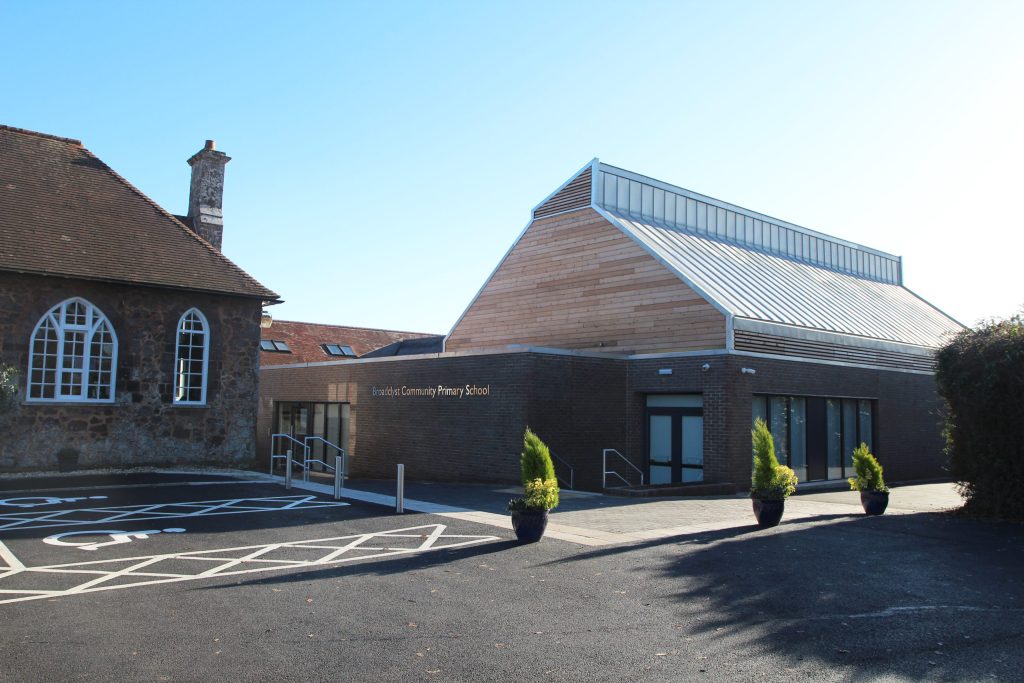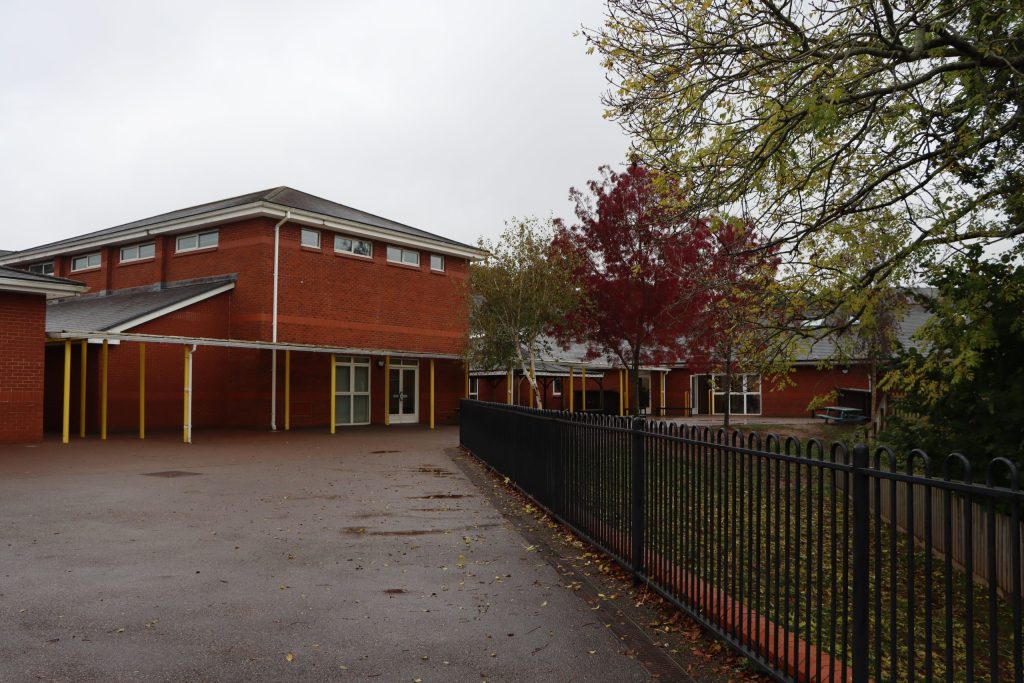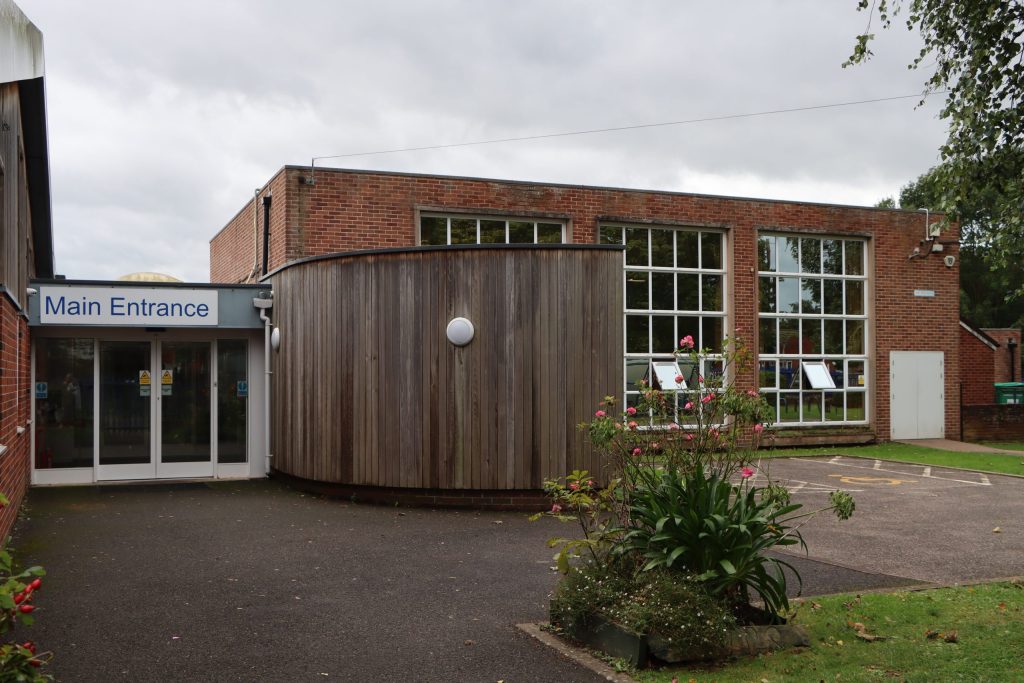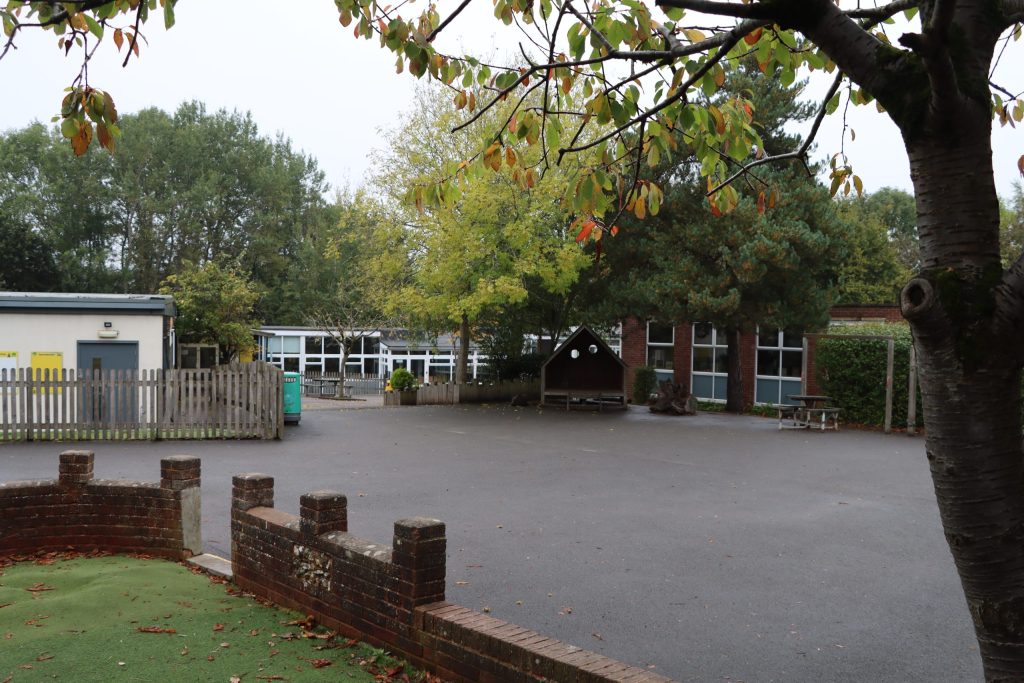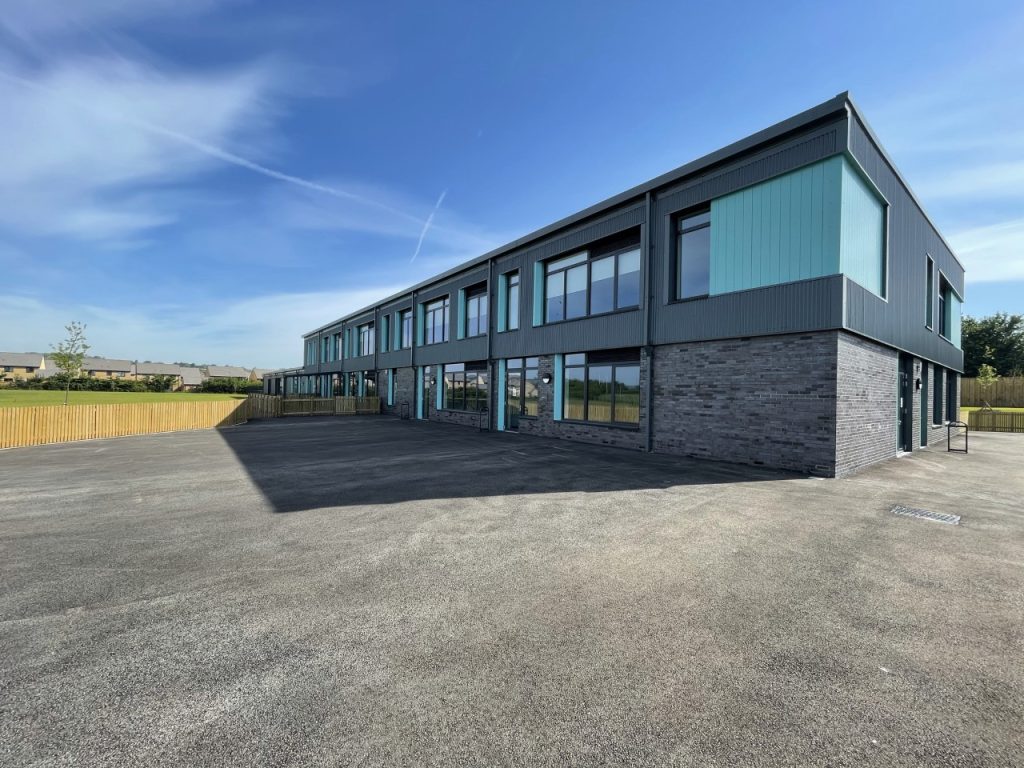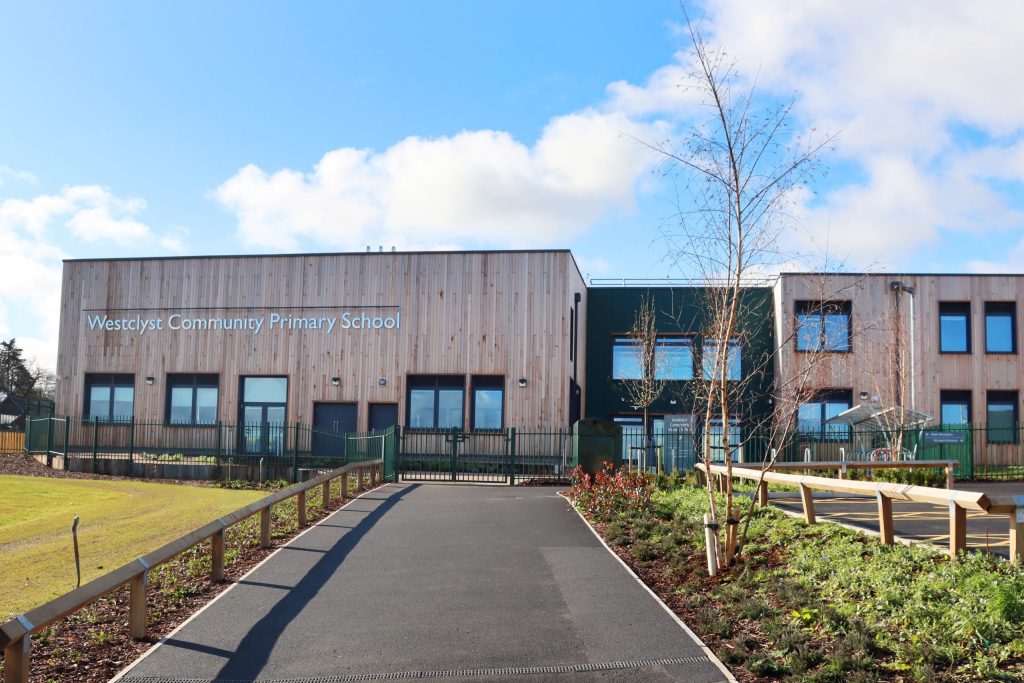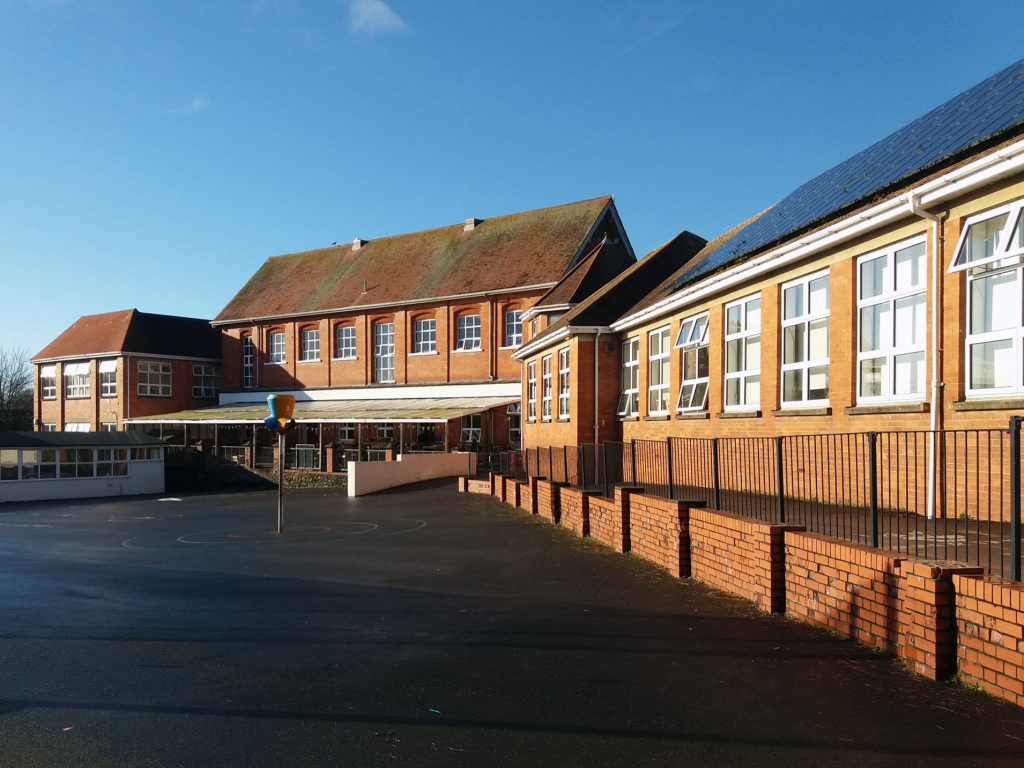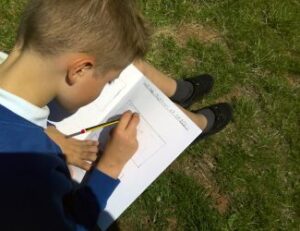
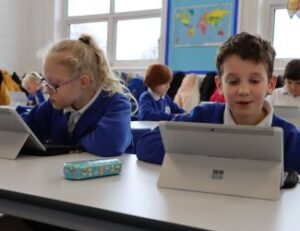
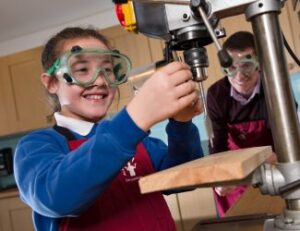
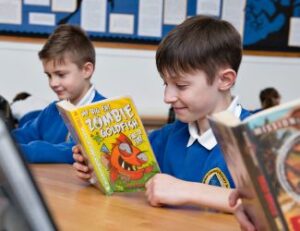
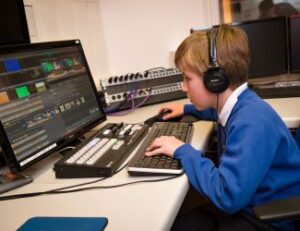
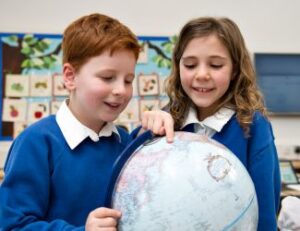
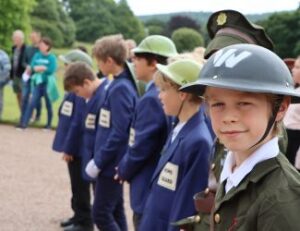
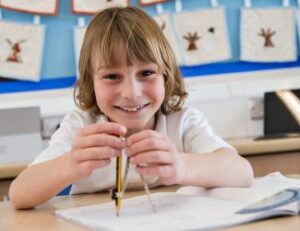


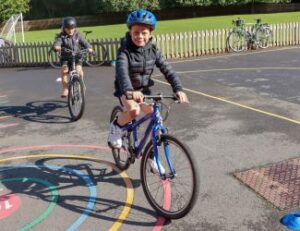
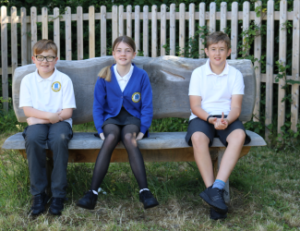
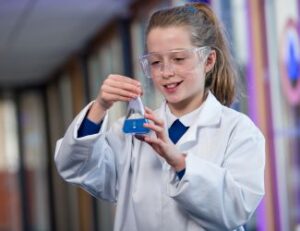
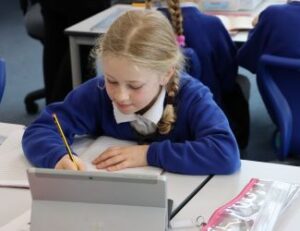
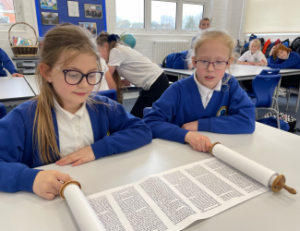
Spoken Language
- Ask relevant questions to extend their understanding and knowledge; take opportunities to learn new vocabulary across all subjects
- Explain what their opinions are and why they hold them, giving evidence in an increasingly articulate manner; give well-structured descriptions, explanations and narratives for different purposes, including for expressing feelings (to a level appropriate to age)
- Maintain attention and participate actively in collaborative conversations such as working together on a curriculum activity, staying on topic and initiating and responding to comments; use spoken language to develop understanding through speculating, hypothesising, imagining and exploring ideas (to a level appropriate to age)
- Speak clearly and audibly and fluently with an increasing command of Standard English; participates in discussions, presentations, performances, role play, improvisations and debates
- Gain, maintain and monitor the interest of the listener(s); consider and evaluates different viewpoints, attending to and building on the contributions of others; select and use appropriate registers for effective communication
Word Reading
- Apply their knowledge of root words, prefixes and suffixes (etymology and morphology) to read aloud and to understand the meaning of new words they meet
- Read exception words, noting the unusual correspondences between spelling and sound, and where these occur in the word
Reading – Comprehension
Engagement in Group and Class Reading
- Listen and discuss a wide range of fiction, poetry, plays, non-fiction and reference books or textbooks
- Read books that are structured in different ways and reading for a range of purposes
- Use dictionaries to check the meaning of words that they have read
- Increase their familiarity with a wide range of books, including fairy stories, myths and legends, and retells some of these orally
- Identify themes and conventions in a wide range of books
- Prepare poems and play scripts to read aloud and to perform, showing understanding through intonation, tone, volume and action
- Discuss words and phrases that capture the reader’s interest and imagination
- Recognise some different forms of poetry [for example, free verse, narrative poetry]
Independent Reading
- Check that the text makes sense to them, discuss their understanding and explains the meaning of words in context; ask questions to improve their understanding of a text
- Draw inferences such as inferring characters’ feelings, thoughts and motives from their actions, and justify inferences with evidence; predict what might happen from details stated and implied
- Identify main ideas drawn from more than one paragraph and summarises these
- Identify how language, structure, and presentation contribute to meaning
Writing
Spelling
- Use prefixes and suffixes and understand how to add them (see English Appendix 1)
- Spell further homophones
- Spell words that are often misspelt (English Appendix 1)
- Place the possessive apostrophe accurately in words with regular plurals [for example, girls’, boys’] and in words with irregular plurals [for example, children’s]
- Use the first two or three letters of a word to check its spelling in a dictionary
- Write from memory simple sentences, dictated by the teacher, that include words and punctuation taught so far
Handwriting
- Use the diagonal and horizontal strokes that are needed to join letters and understand which letters, when adjacent to one another, are best left unjoined
- Ensure that the downstrokes of letters are parallel and equidistant; that lines of writing are spaced sufficiently so that the ascenders and descenders of letters do not touch
Grammar
- Extend sentences with more than one clause by using a wide range of conjunctions, including when, if, be-cause, although
- Use the present perfect form of verbs in contrast to the past tense; chooses nouns or pronouns appropriately for clarity and cohesion and to avoid repetition
- Use conjunctions, adverbs and prepositions to express time and cause
- Use fronted adverbials with commas
- Use the possessive apostrophe with plural nouns; use and punctuate direct speech
- Use the grammatical terminology in English Appendix 2 accurately and appropriately when discussing their writing and reading
Composition
- Plan their writing by discussing writing similar to that which they are planning to write in order to understand and learn from its structure, vocabulary and grammar; discuss and record ideas
- Compose sentences orally (including dialogue), progressively building a varied and rich vocabulary using an increasing range of sentence structures
- Organise paragraphs around a theme; in non-narrative material, using simple organisational devices [for ex-ample, headings and sub-headings]
- Create settings, characters and a plot (during narrative writing)
- Evaluate and edit by assessing the effectiveness of their own and others’ writing by suggesting improve-ments; propose changes to grammar and vocabulary to improve consistency, including the accurate use of pronouns in sentences; proof-read for spelling and punctuation errors
- Read aloud their own writing, to a group or the whole class, using appropriate intonation and controlling the tone and volume so that the meaning is clear.
Number and Place Value
- Count from 0 in multiples of 4, 8, 50 and 100;
- Find 10 or 100 more or less than a given number
- Compare and order numbers up to 1 000
- Identify, represent and estimate numbers using different representations
- Read and write numbers up to 1 000 in numerals and in words
- Tell and write the time from an analogue clock, including using Roman numerals from I to XII, and 12-hour and 24-hour clocks (copied from Measurement)
- Recognise the place value of each digit in a three-digit number (hundreds, tens, ones)
- Solve number problems and practical problems involving these ideas.
Addition and Subtraction
Add and subtract numbers mentally, including:
- A three-digit number and ones
- A three-digit number and tens
- A three-digit number and hundreds]
- Add and subtract numbers with up to three digits, using formal written methods of columnar addition and subtraction
- Estimate the answer to a calculation and use inverse operations to check answers
- Solve problems, including missing number problems, using number facts, place value, and more complex addition and subtraction
Multiplication and Division
- Count from 0 in multiples of 4, 8, 50 and 100 (copied from Number and Place Value)
- Recall and use multiplication and division facts for the 3, 4 and 8 multiplication tables
- Write and calculate mathematical statements for multiplication and division using the multiplication tables that they know, including for two-digit numbers times one-digit numbers, using mental and progressing to formal written methods (appears also in Written Methods)
- Write and calculate mathematical statements for multiplication and division using the multiplication tables that they know, including for two-digit numbers times one-digit numbers, using mental and progressing to formal written methods (appears also in Mental Methods)
- Estimate the answer to a calculation and use inverse operations to check answers (copied from Addition and Subtraction)
- Solve problems, including missing number problems, involving multiplication and division, including positive integer scaling problems and correspondence problems in which n objects are connected to m objects
Fractions (including Decimals and Percentages)
- Count up and down in tenths
- Recognise, find and write fractions of a discrete set of objects: unit fractions and non-unit fractions with small denominators
- Recognise that tenths arise from dividing an object into 10 equal parts and in dividing one – digit numbers or quantities by 10.
- Recognise and use fractions as numbers: unit fractions and non-unit fractions with small denominators
- Compare and order unit fractions, and fractions with the same denominators
- Recognise and show, using diagrams, equivalent fractions with small denominators
- Add and subtract fractions with the same denominator within one whole (e.g. 5/7 + 1/7 = 6/7)
- Solve problems that involve all of the above
Algebra
- Solve problems, including missing number problems, using number facts, place value, and more complex addition and subtraction. (copied from Addition and Subtraction)
- Solve problems, including missing number problems, involving multiplication and division, including integer scaling (copied from Multiplication and Division)
Measurement
- Compare durations of events, for example to calculate the time taken by particular events or tasks
- Estimate and read time with increasing accuracy to the nearest minute; record and compare time in terms of seconds, minutes, hours and o’clock; use vocabulary such as a.m./p.m., morning, afternoon, noon and midnight (appears also in Telling the Time)
- Measure, compare, add and subtract: lengths (m/cm/mm); mass (kg/g); volume/capacity (l/ml)
- Measure the perimeter of simple 2-D shapes
- Add and subtract amounts of money to give change, using both £ and p in practical contexts
- Tell and write the time from an analogue clock, including using Roman numerals from I to XII, and 12-hour and 24-hour clocks
- Estimate and read time with increasing accuracy to the nearest minute; record and compare time in terms of seconds, minutes, hours and o’clock; use vocabulary such as a.m./p.m., morning, afternoon, noon and midnight(appears also in Comparing and Estimating)
- Know the number of seconds in a minute and the number of days in each month, year and leap year
Properties of Shapes
- Draw 2-D shapes and make 3-D shapes using modelling materials; recognise 3-D shapes in different orientations and describe them
- Recognise angles as a property of shape or a description of a turn
- Identify right angles, recognise that two right angles make a half-turn, three make three quarters of a turn and four a complete turn; identify whether angles are greater than or less than a right angle
- Identify horizontal and vertical lines and pairs of perpendicular and parallel lines
Statistics
- Interpret and present data using bar charts, pictograms and tables
- Solve one-step and two-step questions [e.g. ‘How many more?’ and ‘How many fewer?’] using information presented in scaled bar charts and pictograms and tables.
Knowledge
Biology – Plants
- Identify and describe the functions of different parts of flowering plants: roots, stem/trunk, leaves and flowers.
- Explore the requirements of plants for life and growth (air, light, water, nutrients from soil and room to grow) and how they vary from plant to plant.
- Investigate the way in which water is transported within plants.
- Explore the part that flowers play in the life cycle of flowering plants, including pollination, seed formation and seed dispersal.
Biology – Animals Including Humans
- Identify that animals, including humans, need the right types of and amount of nutrition, and that they cannot make their own food; they get nutrition from what they eat.
- Identify that humans and some other animals have skeletons and muscles for support, protection and movement.
Chemistry – Rocks
- Compare and group together different kinds of rocks on the basis of their appearance and simple physical properties.
- Describe in simple terms how fossils are formed when things that have lived are trapped within rock.
- Recognise that soils are made from rocks and organic matter.
Physics – Light
- Recognise that they need light in order to see things and that dark is the absence of light.
- Notice that light is reflected from surfaces.
- Recognise that light from the sun can be dangerous and that there are ways to protect their eyes.
- Recognise that shadows are formed when the light from a light source is blocked by a solid object.
- Find patterns in the way that the size of shadows change.
Physics – Forces and Magnets
- Compare how things move on different surfaces.
- Notice that some forces need contact between two objects but magnetic forces can act at a distance.
- Observe how magnets attract or repel each other and attract some materials and not others.
- Compare and group together a variety of everyday materials on the basis of whether they are attracted to a magnet, and identify some magnetic materials.
- Describe magnets as having two poles.
- Predict whether two magnets will attract or repel each other, depending on which poles are facing.
Working Scientifically
Plan
- Ask relevant questions and use different types of scientific enquiries to answer them
- Set up simple practical enquiries, comparative and fair tests
Do
- Make systematic and careful observations and where appropriate, taking accurate measurements using standard units, using a range of equipment, including thermometers and data loggers
- Gather, record, classify and present data in a variety of ways to help in answering questions
- Record findings using simple scientific language, drawings, labelled diagrams, keys, bar charts, and tables
Review
- Report on findings from enquiries, including oral and written explanations, displays or presentations of results and conclusions
- Identify differences, similarities or changes related to simple scientific ideas and processes
- Use straightforward scientific evidence to answer questions or to support their findings
- Use results to draw simple conclusions, make predictions for new values, suggest improvements and raise further questions
Investigation/Experiments
- A Healthy Plate – Pupils design and create a healthy plate considering the importance of a balanced diet to do so.
- Building a working Human Hand – Pupils create a working hand using strings and straws to work as the skeleton, ligaments and muscles to grip.
- Chocolate Rocks – Chocolate is used by pupils to show the different processes which create metamorphic, sedimentary and igneous rocks.
- Roots of a Plant – Pupils will examine the root system of a plant by unearthing one and then photographing and labelling key parts.
- Shadow Puppet Theatres – Pupils use their knowledge of Light and Shadow to create shadow puppet theatres.
- Floating Compass – Pupils will use their knowledge of magnetism to create a floating compass that can help them navigate their Eggy Challenge Boat.
Two eras of World History: Mayan Civilization & the Shang Dynasty
- To build upon the pre-history learnt in Year 1 and 2 around Ancient Egypt, Wonders and Greece.
- Who the Mayans were, where they lived and how they lived.
- To explore the sacred nature of crops.
- The importance of Mayan temples and how they were constructed.
- Inventions of the era: codes, calendar, counting systems.
- Extend global historical knowledge through Mayan culture and Shang Dynasty.
- What life was like in Shang China for the Dynasty and the population.
- Why cities were founded in their chosen locations.
- Information around Shang and Mayan weaponry and battles.
- Who people of Shang China worshiped.
- The importance of Fu Hao and the role women played in Shang China.
A Local Historical Study: The Roman Empire
- To build upon their pre-history learnt in Year 1 and 2.
- How the Roman Empire grew and how its power spread.
- The influence that the Romans had on Britain.
- About the British Resistance of the Roman invaders.
- The importance of Hadrian’s Wall
- The impact Romans had on Exeter/Barnstaple.
- Roman attitudes towards race and slavery.
- How Boudica was a leader and the difficulties that women faced in Roman Britain.
An investigative chronological enquiry: ‘Which invention has impacted our lives the most?’
- To investigate a range of inventions and inventors from throughout history.
- To recognise the impact of events in the past on modern life.
- To use relevant phrases and vocabulary to support in enquiry.
- To place key events on a timeline and use this to support the retelling of past events.
- To draw comparisons between our lives today and the lives of others in the past.
An Area of Human Geography: Region Comparison
- To understand human geographical similarities and differences through the study of city locations, size and layout in five distinct world regions: Britain, Italy, Spain, Belize and Mexico.
- To consider the historical implication of city locations and how they were established.
- To discuss city structure in each region and consider why there might be differences.
An area of Physical Geography: Region Comparison
- To understand physical geographical similarities and differences through the study of rivers, coasts and mountain ranges in five distinct world regions: Britain, Italy, Spain, Belize and Mexico.
- To locate hot and cold areas of the world by identifying the equator.
- To describe and understand the formation of volcanoes and how they erupt.
- To describe and understand the formation of mountains and ranges.
A range of Geographical skills: Map Reading, Map Making & Fieldwork
- To use world maps, atlases, globes and digital maps to make simple routes.
- To use simple grids and give directional instructions up to 8 cardinal points.
- To use four-figure coordinates to locate features.
- To devise a map of a small area with features to scale in the correct location.
- To continue learning how to use scale.
- To use digital maps to add a range of annotation and text to explain features.
- Use fieldwork and observational skills to measure, record and present physical and human features of a local aera, including a range of methods: sketch maps, plans, graphs and digital technologies.
- Why local areas have changed over the past 2000 years, identifying their land use and human features that have changed.
- To consider the importance of qualitative and quantitative data through shops/houses/flats/parks/libraries as well as the population.
Learning about Religion: Journeys
- About who Sikhs are and who they worship.
- To recall the rules Sikhs follow.
- To identify physical places of worship and locations that people travel to.
- To consider spiritual journeys that people may take from different belief perspectives.
Learning from Religion: ‘The end is more important than the journey. Discuss.’
- To explore the special journeys that people make, including pilgrimages, marriage, death.
- To consider why people mark significant events of their life.
- To discuss life as a journey.
- To compare pilgrimages made by people of different beliefs.
British Council Theme for Global Citizens: Identity and Belonging
- To explore the concept of social identity and the groups we belong in.
- To gain an appreciation and understanding of global cultures.
- To consider the positives of being different.
Computer Science
- To learn how to use sequencing in programming through Scratch and MakeCode.
- To learn selection of motion, sound, and event blocks which they will use to create their own programs, featuring sequences.
- To make a representation of a real world tool, such as a piano.
- To learn to apply the stages of program design through this unit.
- To understand that sequences of commands have an outcome, and make predictions based on their learning.
Information Technology
- To develop their understanding of what a branching database is and how to create one.
- To understand what attributes are and how to use them to sort groups of objects by using yes/no questions.
- To create physical and on-screen branching databases.
- To evaluate the effectiveness of branching databases and decide what types of data should be presented as a branching database.
- To use the terms ‘text’ and ‘images’ and understand that they can be used to communicate messages.
- To use desktop publishing software and consider careful choices of font size, colour and type to edit and improve premade documents.
- To use the terms ‘templates’, ‘orientation’, and ‘placeholders’ and begin to understand how these can support them in making their own template for a magazine front cover.
- To add text and images to create pieces of work using desktop publishing software.
- To evaluate a range of page layouts thinking carefully about the purpose of these and how and why desktop publishing is used in the real world.
- To use a range of techniques to create a stop-frame animation using tablets.
- To apply those skills to create a story-based animation.
- To add other types of media to their animation, such as music and text.
- To develop their understanding of digital devices, with an initial focus on inputs, processes, and outputs.
- To compare digital and non-digital devices.
- To understand the structure and purpose of computer networks, including devices that make up a network’s infrastructure, such as wireless access points and switches.
Digital Literacy
- To use technology safely, respectfully and responsibly; recognise acceptable/unacceptable behaviour; identify a range of ways to report concerns about content and contact.
Sewing the Seasons
- The children will learn how to thread a needle.
- How to sew using a running stitch.
- The children will be challenged to pick an appropriate fabric and colour for their chosen season.
Christmas Card Design
- Use a variety of controlled and fine-brush skills and techniques using inks or watercolours.
- Introducing how to control wet colours and bleeding into them with other colours to create interesting effects.
- Diagonal brushstrokes and flicking and twisting the end to achieve a quality finish. Metallic paint applied using handle of brush in a stippling-style technique.
Still Life Painting
- Explore the effect on paint of adding water, glue, sand, sawdust and use this in a painting.
- Represent things observed, remembered or imagined, using colour selecting appropriate paint and brushes.
- Use a viewfinder to select a view and visual clues in an image, then record what is in the frame
- Plan the use of a camera to take a specific photo or set of photos
- Building upon painting techniques from previous years, learn about specific techniques such as impasto.
- Learning when and how to use different brushes for varying purposes using acrylic paint.
Mayan Mask Making
- They will develop the following techniques: painting, cutting, folding, sticking.
- Learning how to apply to paint to a functional object (mask).
- Represent things observed, remembered or imagined, using colour selecting appropriate paint and brushes
- Introduces different types of brushes for specific purposes
- Improve skills of overlapping and overlaying to place objects in front and behind
- Cut multiple shapes with scissors and arrange /stick these on a surface for a purpose
Roman Clay Coil Pot
- Building on clay manipulation skills children apply these skills in a more controlled and precise way and using modelling tools to enhance work: rolling, coiling, score, slip, stick.
- Use clay to construct a simple functional form such as a coil pot, smoothing and joining clay with care.
- Build in clay a functional form using two/three building techniques and some surface decoration
Representing Form via Drawing:
- To show light and dark and depict form and depth using shading techniques
- Light and darks – creating form using chalk and charcoal.
Roman Portraiture/Busts – Drawing a Profile from a Photo
- Using photography and shadows – tracing to capture an accurate image.
- Adding detail then reducing scale digitally.
- Plan the use of a camera to take a specific photo or set of photos
- Uses line, tone, shape and mark with care to represent things seen, imagined or remembered.
- Experiment with creating mood, feeling, movement and areas of interest using different media.
- Use a painting program to make an image corresponding to their work in painting and digital collage to create a portrait in profile.
Shang Dynasty Inspired Art – Wax Etchings
- New technique of etching requires fine drawing skills which adds to drawing skills learnt in previous projects.
- Introducing textures and effects from drawing upon different materials.
- Observe patterns from vases and artefacts.
- Recreate a pattern inspired by vases from the Shang Dynasty.
Watercolour Landscapes
- Applying paint in a different way to that of the impasto techniques that were previously taught.
- Using water as a basis for the painting from water washes; applying with a wide brush (not previously introduced).
- Observing and learning how the paint behaves differently to other paints to create different effects and textures.
Knowledge
- Understand and apply the principles of a healthy and varied diet.
- Prepare and cook a variety of predominantly savoury dishes using a range of cooking techniques.
- Understand seasonality, and know where and how a variety of ingredients are grown, reared, caught and processed.
- Apply their understanding of how to strengthen, stiffen and reinforce more complex structures.
- Select from and use a wider range of tools and equipment to perform practical tasks [for example, cutting, shaping, joining and finishing], accurately.
- Select from and use a wider range of materials and components, including construction materials, textiles and ingredients, according to their functional properties and aesthetic qualities.
Project
- Eggy Challenge: Motorised Boats – Pupils will use their knowledge of different materials and which ones float or sink, in order to create a boat. The boat will be motorised and needs to transport an egg across a body of water.
- Authentic Mexican cuisine: As part of the Mayan project, pupils create tortillas, salsa and guacamole.
Singing
- Sing a widening range of unison songs of varying styles and structures with a pitch range of do–so, tunefully and with expression. Perform forte and piano
- Perform actions confidently and in time to a range of action songs
- Walk, move or clap a steady beat with others, changing the speed of the beat as the tempo of the music changes.
- Perform as a choir in school assemblies.
Listening
The following styles of music will be introduced as well as recapping on styles that have been taught in previous years.
Western Classical Tradition and Film:
- Baroque e.g Handel
- Romantic e.g Mussorgsky
- 21st Century e.g A.R.Rahman
Popular Music:
- Funk e.g James Brown
Musical Traditions:
- India- Indian Classical e.g Kishori Amonkar
Improvise
- Become more skilled in improvising (using voices, tuned and untuned percussion and instruments), inventing short ‘on-the-spot’ responses using a limited note-range.
- Structure musical ideas (e.g. using echo or question and answer phrases) to create music that has a beginning, middle and end.
Compose
- Combine known rhythmic notation with letter names to create rising and falling phrases using just three notes (do, re and mi)
- Compose song accompaniments on untuned percussion using known rhythms and note values.
Performing
- Develop facility in playing tuned percussion or a melodic instrument such as an ukulele. Play and perform melodies following staff notation using a small range (e.g. Middle C–E/do–mi) as a whole class or in small groups (e.g. trios and quartets).
- Use listening skills to correctly order phrases using dot notation
- Individually (solo) copy stepwise melodic phrases with accuracy at different speeds; allegro and adagio, fast and slow.
Reading Notation
- Introduce the stave, lines and spaces, and clef. Use dot notation to show higher or lower pitch.
- Introduce and understand the differences between crotchets and paired quavers.
- Apply word chants to rhythms, understanding how to link each syllable to one musical note.
Relationships: Friendship; making positive friendships, managing loneliness, dealing with arguments; families; family life; caring for each other
- How friendships support wellbeing and the importance of seeking support if feeling lonely or excluded
- How to recognise if others are feeling lonely and excluded and strategies to include them
- How to build good friendships, including identifying qualities that contribute to positive friendships
- That friendships sometimes have difficulties, and how to manage when there is a problem or an argument between friends, resolve disputes and reconcile differences
- How to recognise if a friendship is making them unhappy, feel uncomfortable or unsafe and how to ask for support
Health and Wellbeing: Keeping safe; at home and school; our bodies; hygiene; medicines and household products; being healthy: eating well, dental care; being healthy: keeping active, taking rest
- How to recognise hazards that may cause harm or injury and what they should do to reduce risk and keep themselves (or others) safe
- How to help keep their body protected and safe, e.g. wearing a seatbelt, protective clothing and stabilizers
- That their body belongs to them and should not be hurt or touched without their permission; what to do and who to tell if they feel uncomfortable
- How to recognise and respond to pressure to do something that makes them feel unsafe or uncomfortable (including online)
- How everyday health and hygiene rules and routines help people stay safe and healthy
- How to eat a healthy diet and the benefits of nutritionally rich foods
- How to maintain good oral hygiene (including regular brushing and flossing) and the importance of regular visits to the dentist
- How not eating a balanced diet can affect health, including the impact of too much sugar/acidic drinks on dental health
- That eating and drinking too much sugar can affect their health, including dental health
- How people make choices about what to eat and drink, including who or what influences these
- How, when and where to ask for advice and help about healthy eating and dental care
- How regular physical activity benefits bodies and feelings
- How to be active on a daily and weekly basis – how to balance time online with other activities
- How to make choices about physical activity, including what and who influences decisions
- How the lack of physical activity can affect health and wellbeing
- How lack of sleep can affect the body and mood and simple routines that support good quality sleep
- How to seek support in relation to physical activity, sleep and rest and who to talk to if they are worried
Living in the Wider World: Community; belonging to groups; similarities and differences; respect for others
- How they belong to different groups and communities, e.g. friendship, faith, clubs, classes/year groups
- What is meant by a diverse community; how different groups make up the wider/local community around the school
- How the community helps everyone to feel included and values the different contributions that people make
- How to be respectful towards people who may live differently to them
- The responsibilities they have in and out of the classroom
- Use running, jumping, throwing and catching in isolation.
- Play competitive games, modified where appropriate, and identify basic principles suitable for attacking and defending.
- Create sequences of different actions using floor or apparatus in order to develop flexibility, strength, technique, control and balance.
- Use a range of jumping and throwing techniques in Athletics.
- Create controlled movement patterns in Dance.
- Experience outdoor and adventurous activity individually.
- Identify the effect on the body when taking part in a range of activities; i.e. heart rate, breathing.
- Swim competently, confidently and efficiently over a distance of at least 25 metres.
- Use a range of strokes effectively, including front crawl, backstroke and breaststroke.
- Perform safe self-rescue in different water-based situations.
Prepare for surviving in the outdoors during Forest School sessions
- Learning how to tie different knots and understand their specific uses
- Use knives to make tent pegs for their dens
- Use knots to make a den to protect themselves
- Light small 5 minute controlled fires
- First aid techniques
Residential
- Develop fire building and starting techniques and recap the fire triangle.
- Learning how to adapt to a range of weather conditions in the outdoors.
- Use a variety of tools to cut natural materials for different purposes.
- Introduction to foraging skills and identifying different uses for common plants.
Language Knowledge
- To count to 50
- To hold a conversation about themselves (including topics from previous years)
- Sizes (short, long, thin etc.)
- Food and drink (meals, fruits, vegetables, fruits, groceries)
- Healthy lunch boxes
- Transport
- Subjects in school
- Places in school
Speaking and Listening
- I can listen carefully to spoken Spanish and respond.
- I can speak in basic sentences, using familiar vocabulary and phrases.
- I can lead in and appreciate stories, songs, poems and rhymes in Spanish.
- I am developing accurate pronunciation and intonation so that others understand me when using words I know.
- I can engage in conversations; ask and answer questions; express opinions and respond to those of others; seek clarification and help.
- I can present ideas and information orally to the class.
Reading and Writing
- I can link the spelling, sound and meaning of words.
- I can spell basic vocabulary, forming simple Spanish sentences.
- I an read carefully and show understanding of words, phrases and simple writing in Spanish.
Year 3
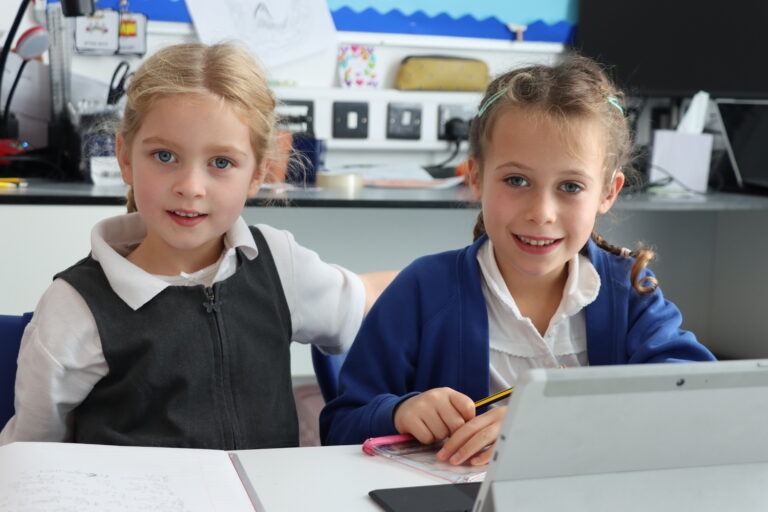
Year 3 marks the first year in KS2, where class teachers’ begin to foster greater independence within pupils and supporting them with the key stage transition. With a renewed emphasis on the broader curriculum, Year 3 also have the opportunity to continue Forest School, attend swimming lessons and attend their first school residential.
Our Year 3 Teachers
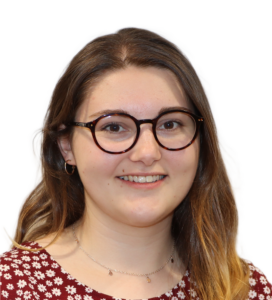
Broadclyst
Lottie Moulster

Broadclyst
Guy Wakefield

Monkerton
Luke Hawkey
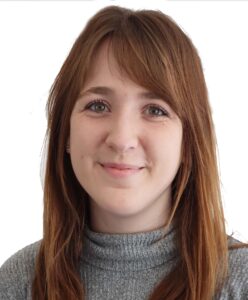
Monkerton
Hannah Claydon
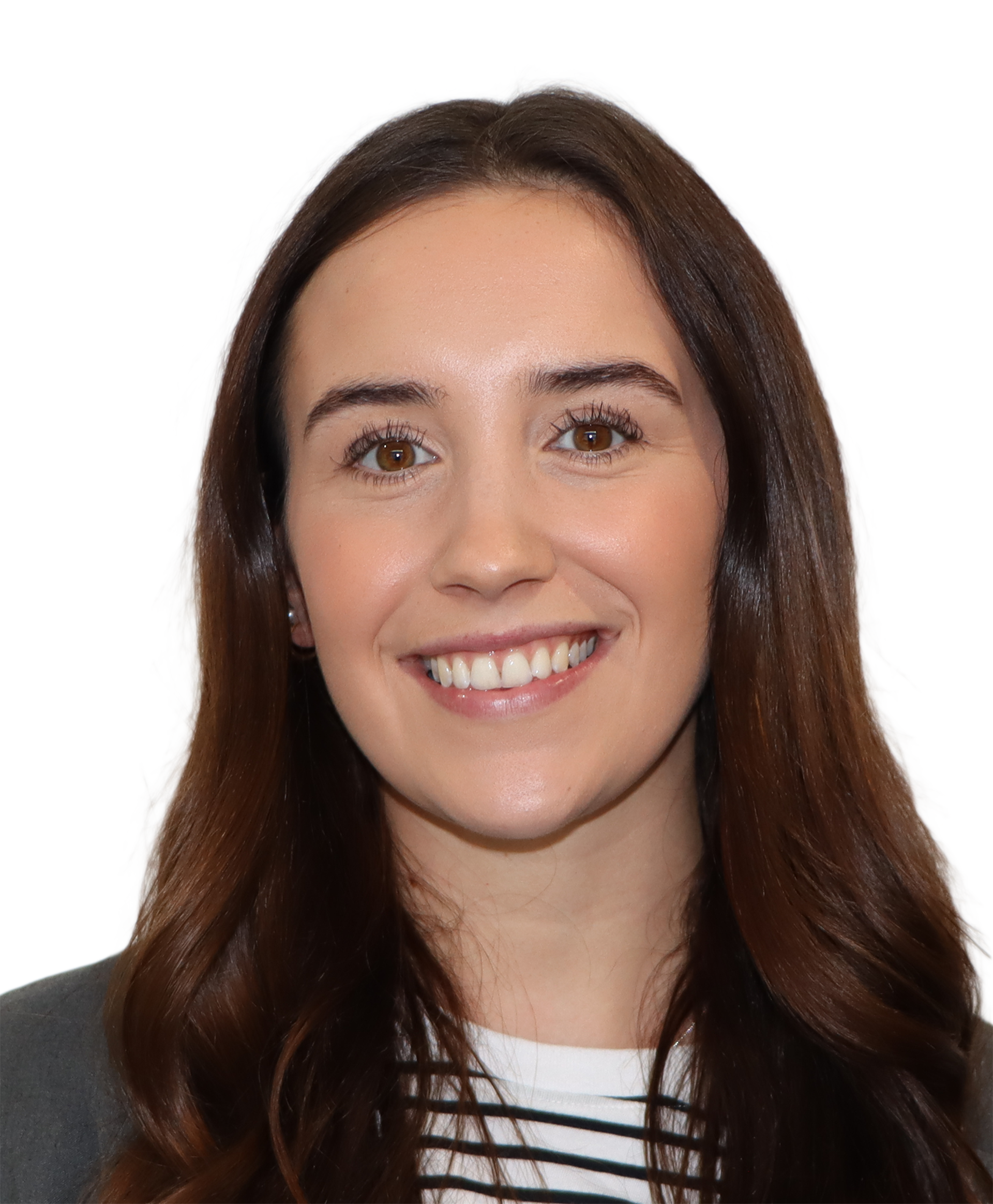
Westclyst
Lauren Francis
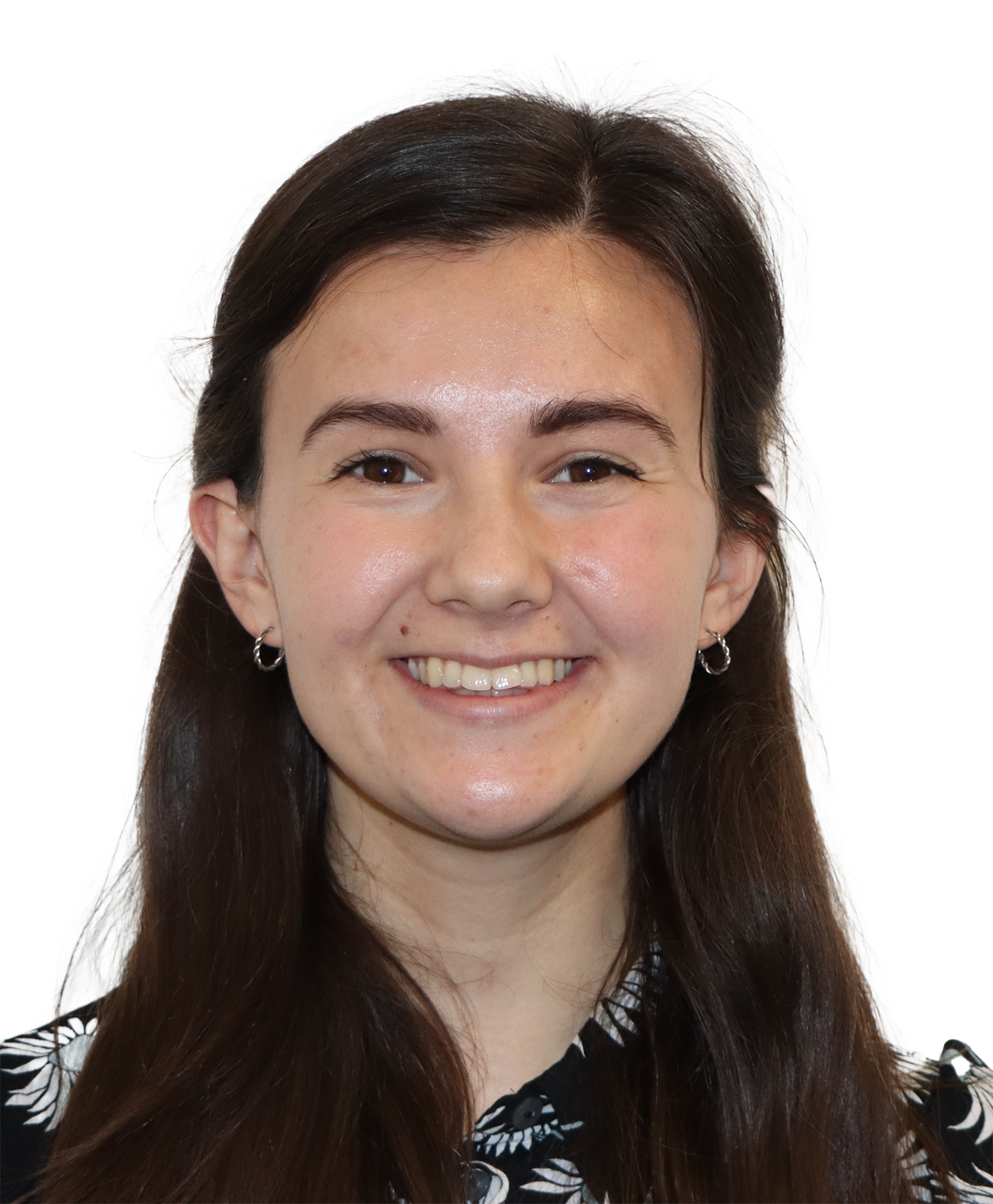
Westclyst
Niamh Evans
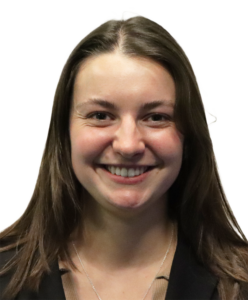
Yeo Valley
Jessica Hunt
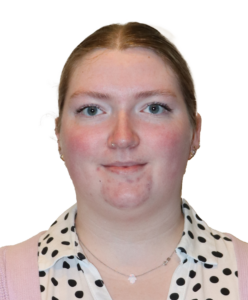
Marpool
Ofek Voisey
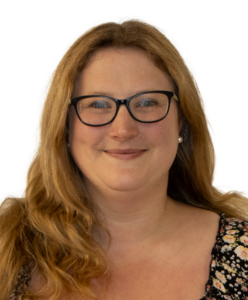
Countess Wear
Rachel Pill




